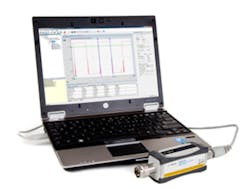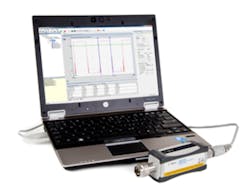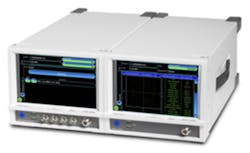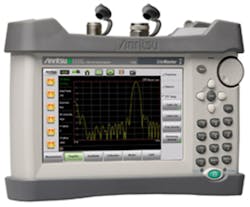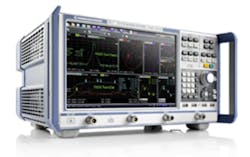Products Highlight Design and Test Link
Test-equipment vendors highlighted various capabilities and instruments at the International Microwave Symposium. Specific areas of focus included noise measurements, wafer probing, nonlinear measurements, radar test, and wireless communications test. In addition, companies involved in both design and test emphasized the importance of the relationship between the two disciplines and described how they serve both areas.
Agilent Technologies, for example, chose the show to tout its alignment of business units to support design simulation and measurement automation. Mark Pierpoint said the company has merged its modular instrument and software units into what’s now called the Software & Modular Solutions Division, for which he serves as vice president and general manager. The combination, he said, is a natural one—PXI, AXIe, and PXIe instruments lack front panels and knobs, making software a key component of modular-instrument-based systems.
Pierpoint said one of Agilent’s goals is to help its customers get products such as tablets to market quickly despite the challenges they face. Permutations of different modes in such products create a validation nightmare, he said, and standards are barely ratified before deployment. Traditionally, he added, design and validation involve separate teams using different tools, resulting in multiple expensive iterations. Connecting design to validation—thereby linking the EDA and measurement worlds—ameliorates such problems, he said.
Pierpoint cited several technologies involved in the EDA-to-measurement link, including the NeuroFET model, an artificial neural-network measurement-based FET model that supports simulation in IC-CAP and simulation in ADS. NeuroFET, he said, accurately models 2nd, 3rd, and Nth order effects while supporting robust RF and DC convergence. It applies to GaAs switches, mixers, and amplifiers.
In addition, Pierpoint highlighted X-parameters, which enable nonlinear circuit system simulation and measurement and are supported by Agilent instruments as well as software tools including ADS, Genesys, GoldenGate, and SystemVue.
A particular challenge faced by engineers, Pierpoint said, stems from digital predistortion (DPD), which applies to 4G wideband systems with wider bandwidths and higher crest factors. Agilent, he explained, offers simulation-based DPD tools as well as measurement-based instruments capable of investigating DPD issues.
Pierpoint noted that although Agilent’s software and modular-instrument divisions have merged, “The software remains hardware-agnostic and continues to work with benchtop and rack-mounted instruments.”
Pierpoint cited a variety of design and simulation tools, including the next major release of ADS, which features side-by-side finite-element-method EM simulation of different technologies, model support for NeuroFET, and enhancements to both the ADS Load Pull and the ADS Amplifier DesignGuide. The company also highlighted its latest version of EMPro 2012 Electromagnetic Professional software, which supports the creation of 3-D models and the analysis of the electrical performance of packages, connectors, antennas, and other RF and high-speed components. The new ADS offers improved integration with EMPro.
Agilent also highlighted GoldenGate 2012, the latest release of its RFIC simulation, verification, and analysis software with enhancements for accelerated design verification, extended design-for-manufacturing solutions, and improved links to system design. In addition, the company demonstrated SystemVue 2012.06, which provides deeper design-flow integration of baseband signal-processing tools with intellectual property reference libraries, RF electronic design automation tools, and test equipment. The software enables system architects to predict and cross-verify baseband and RF physical-layer performance at earlier phases of the design process, enabling faster deployment of 4G, WLAN, and aerospace/defense systems.
Connecting LabVIEW with VSS
Also focusing on the intersection of design and test was National Instruments (NI). The company highlighted new connectivity between the NI LabVIEW system design software and the AWR Visual System Simulator (VSS) software for RF and microwave system design. The company calls the initiative the first major joint development between NI and AWR following NI’s acquisition of AWR, adding that the new connectivity helps engineers to better use measurements in the design flow by executing LabVIEW code directly from the AWR design environment.
The AWR design environment now incorporates LabVIEW signal-processing capabilities, including multirate digital signal processing (DSP), wireless standards, modulation, and fixed-point math. Engineers can integrate VHDL and LabVIEW FPGA Module code through NI FPGA-based hardware directly into VSS diagrams, and new connectivity to both PXI and traditional RF instrumentation makes it easier to incorporate measurement data into simulations.
Joe Pekarek, chief technology officer at AWR, said, “This integration between NI LabVIEW and AWR VSS is the direct result of our first joint initiative,” adding that more product integration will occur in the future.
In addition, NI said it is collaborating with TU-Dresden on the exploration of new technologies for 5G wireless systems using NI LabVIEW system design software. While the research will encompass a variety of system concepts, it will focus on the evolution of orthogonal frequency-division multiplexing (OFDM) technology.
Dr. James Truchard, president, CEO, and cofounder of National Instruments, described TU-Dresden as a top research university that’s “…leading the way in groundbreaking research to prototype next-generation wireless communications systems.” He added, “We are proud to accelerate the development of future technologies that will ultimately impact anyone who uses a cellphone.”
TU-Dresden previously pioneered 3G systems research with support from Vodafone, which sponsors the university’s mobile communications systems work. “NI RF and communications tools will enable us to design OFDM prototyping systems within a single software design flow,” said Dr. Gerhard Fettweis, the Vodafone Mobile Communications Systems Chair, in a press release. “With the modular NI PXI system, we can start with a SISO link and expand to complex MIMO configuration with limited modifications to the code, exceeding an 8×8 setup as our research evolves.”
New Instruments and Enhancements
In addition to design and simulation software, several vendors focused on new instruments or instrument enhancements.
Courtesy of Agilent Technologies
Agilent, for example, introduced the U2020 X-Series USB Power Sensors (Figure 1), which provide at least 3,500 readings/s, incorporate built-in trigger functions, and offer the capability to operate without a power meter or external power supply. The U2020 X-Series USB peak and average power sensor family includes the U2021XA (50 MHz to 18 GHz) and U2022XA (50 MHz to 40 GHz); they are priced at $6,700 and $7,100, respectively.
Also on display were five new PNA-L vector network analyzer (VNA) models, offering design and manufacturing engineers frequency ranges up to 50 GHz. The new N523xA PNA-L VNAs replace existing N5230C models. The models feature both increased measurement range (5 dBm more output power and 20 dB more dynamic range) and speed (the result of a new synthesizer with faster frequency switching). They also offer an improved user interface with a 24% bigger display. Because the models are 100% compatible with the N5230C PNA-L, no changes to the user’s current test setup are required.
Agilent exhibited a variety of recently introduced products, including a MIMO PXI vector signal analyzer, signal generators, and FieldFox RF Analyzers with options for time-domain and channel-power measurements. And finally, the company demonstrated its EXA Signal Analyzer, which it calls the industry’s most cost-effective millimeter-wave (mm-wave) signal analyzer. It covers frequencies to 44 GHz or, with external mixing, to 325 GHz.
IEEE 802.11ac Support
Courtesy of Aeroflex
Aeroflex announced that it has added IEEE 802.11ac capability to its S-Series RF Signal Generator and Analyzer product line (Figure 2) introduced in 2010. Designed for use by engineers in WLAN research, design, and manufacturing, the new 802.11ac capability is available for the SGD RF Digital Signal Generators (Option 119) and the SVA Vector Signal Analyzers (Option 110).
The S-Series product line’s standard features include a wide bandwidth at 200 MHz, level and frequency settling times of 100 µs, and very low phase noise performance (-135 dB/Hz at 1 GHz, 20-kHz offset).
The S-Series’ wide bandwidth is suitable for WLAN R&D. For manufacturing, the fast settling times enable rapid device throughput. Using Aerolock, the S-Series instruments can be locked together to build complex test setups. Two instruments are combined within a width of 19 inches, allowing both transmit and receive functions in one small space.
“The need for increased device speed, data rates, network capacity, and wide bandwidth has put pressure on the instrument’s hardware to maintain modulation accuracy and increased bandwidth. The S-Series is highly accurate and, with 200 MHz factory-calibrated bandwidth, we can easily cover the needs of 802.11ac with plenty of room for future technologies,” said David Asquith, Aeroflex’s product line manager for the S-Series.
The SGD’s WLAN signal generation suite is now updated for 802.11ac, supporting bandwidths of 20, 40, 80, 80+80, and 160 MHz and up to eight spatial streams. Using an embedded version of Aeroflex’s IQCreator waveform creation software, 802.11ac waveforms are quickly created and played from within the signal generator.
Testing 256QAM modulation demands lower EVM within the test system, Asquith said. To achieve low EVM, Aeroflex developed a new type of factory calibration to maintain orthogonality (the 90° relationship between I and Q) as the baseband frequency increases. Aeroflex’s calibration mechanism effectively creates a digital filter that predistorts the baseband signal before it is applied to the IQ modulator. This new method gives the SGD its 200-MHz of factory-calibrated signal bandwidth and enables testing of the very latest wireless devices.
The SVA offers high linearity and low noise, and it includes a built-in spectrum analyzer. The SVA’s WLAN measurement suite with 802.11ac capability features measurement tools enabling analysis of WLAN OFDM, DSSS, and DSSS-OFDM RF signal characteristics in accordance with IEEE 802.11a, b, g, n, and ac. In addition to support for 802.11ac, generic measurement capabilities are included as standard, and a range of optional modulation analysis suites extends measurement support to a variety of communications standards within the same application framework. Measurement capabilities include power, spectrum, and modulation analysis with results displayed in two user-configurable windows.
Noise-Figure Measurements
Anritsu introduced noise-figure measurements for its VectorStar MS4640A and ME7838A VNAs to provide designers, modelers, and manufacturers of RF/microwave amplifiers with a new capability. Steve Reyes, product marketing manager for network analyzers, said Option MS4640A-041 equips VectorStar to be the only VNA family with 70-kHz to 125-GHz noise-figure measurement, enabled in part by a unique receiver optimized for measurements from 30 GHz to 125 GHz.
Noise-figure measurements allow test engineers to determine potential degradation of signal-to-noise ratio from system components in applications including radar, wireless communications, and digital communications. These design engineers often have to balance the conflicting demands of meeting higher performance requirements with lower budgets in shorter times.
The receiver used to perform the VNA-based noise-figure measurements at 125 GHz incorporates a design focusing on improved noise performance and reduced sensitivity-to-source impedance, Reyes said. The result is a robust capability to make high-quality microwave and mm-wave noise-figure measurements on a wide variety of active devices.
For less experienced test engineers, configuring a noise-figure test setup can be particularly challenging. It often is necessary to add pre-amplification and filtering in front of the measurement receiver to ensure sufficient sensitivity to make a quality measurement. If too little amplification is used, there may be excessive jitter from the instrument A/D converter. If too much power or amplification is applied, compression can impact the measurements.
These two constraints form the effective noise-figure measurement range and can limit the flexibility a user has in choosing pre-amps and filters. The MS4640A-041 option takes advantage of the VectorStar architecture to provide a wider noise-figure measurement range and greater configuration flexibility. In addition, Anritsu enables the use of a simple, low-cost termination, rather than a specialized noise source, as part of the cold source noise-figure measurement method. These advantages result in an easier-to-use, more flexible test system. The MS4640A-041 option for noise-figure measurement capability is priced at $15,000. The 125-GHz receiver, Model SM6609, costs $30,250.
In addition, Anritsu demonstrated mm-wave emission testing using its MS2830A Signal Analyzer and BridgeWave Communications’ 80-GHz Wireless Ethernet Bridge. Reyes noted that the cellular industry is adopting E-band (60 to 90 GHz) gigabit data rate radios for 4G/LTE as it looks to solve the backhaul bottleneck challenge.
Anritsu introduced a four-port configuration for its ME7838A VectorStar that extends the VNA measurement system’s capability to 750 GHz and higher. The ME7838A provides R&D engineers designing four-port or differential mm-wave components with the capability to sweep power across a wide range at frequencies up to 750 GHz using external mm-wave modules without the need for manual attenuators.
Courtesy of Anritsu
The company also presented the Site Master S331L Cable and Antenna Analyzer, which serves in the deployment, installation, and maintenance of wireless networks (Figure 3). The S331L, which covers 2 MHz to 4 GHz, performs return loss, cable loss, and Distance-to-Fault (DTF) measurements. It offers a sweep speed per data point of 1.5 ms (typical) to enable easier identification of intermittent problems in real time. The S331L also features a standard built-in power meter.
The instrument provides eight hours of continuous battery life. It is dust and splash resistant, has a backlit 7-inch TFT touch-screen display, and weighs less than 4.4 lb including a battery. It can store more than 1,000 files (representing sweeps, setups, and screenshots, for example) internally on the analyzer. Every Anritsu Site Master S331L also includes SweepMasters DIRECT, a service that allows S331L users to capture, upload, and deliver traces. Site traces can be emailed as links to the stored traces as well as converted to a .PDF report containing plots of the uploaded traces.
The S331L also can be used with Sweep Master Pro, an enterprise-level, web-based line sweep and tracking tool for large multiple cell-site installation and maintenance projects, and Line Sweep Tools (LST), a free PC-based program that increases productivity for users responsible for recording numerous cable and antenna traces daily. The S331L costs $6,750.
Analyzer Options
Rohde & Schwarz highlighted a variety of instrument features at the show. The company said a new R&S FSW signal-analyzer pulse-measurement option (FSW-K6) speeds up analysis of radar systems. In addition, the R&S FSW-K17 option for the FSW enables the signal analyzer to perform group-delay measurements, which traditionally have been carried out using a VNA. Also for the FSW, the company added support for analyzing 802.11ac signals with bandwidths up to 160 MHz.
Courtesy of Rohde & Schwarz
Rohde & Schwarz also announced enhancement to its R&S ZNB VNAs (Figure 4). The ZNB-K4 software option supports frequency-converter measurements; it includes a graphical wizard that simplifies the setup and execution of complex measurements. In addition, the ZNB-K14 option enables the ZNB instruments to measure intermodulation distortion.
Cascade Microtech was on hand to highlight a variety of wafer-probing capabilities. The company exhibited its InfinityQuad probes, which support four-quadrant probing of a DUT. Cascade described the challenges of small-pad probing that the InfinityProbe devices alleviate; the challenges include large probe-tip to contact area, poor tip planarity, overtravel-to-skate ratios, tip accuracy, high contact resistance on aluminum pads, side skating, and yaw-axis errors. The company also presented an application note that describes N+1-Port SOLT/SOLR calibration for the probes.
Wireless Telecom Group addressed the need for circuit designers to closely examine Vcc and ground architectures as component integration and ultrafast switching increases, causing noise to permeate the power supply. The company’s approach is to use the Noisecom JV9000 Noise Generator to inject clearly defined, repeatable noise levels to Vcc to let engineers study their systems’ noise response.
NMDG targeted nonlinear measurement, announcing the capability to accurately characterize and model the behavior of mixers using the firm’s ZVxPlus nonlinear extension kits for the Rohde & Schwarz ZVA/ZVT Series VNAs. The new capability takes advantage of the extended multiport measurement feature in NMDG’s Integrated Component Characterization Environment (ICE) software. NMDG said its “primary mixer S-functions” model is similar to S-parameter models and can be cascaded with other blocks.
Mesuro representatives also were on hand to highlight open-loop, active harmonic load-pull solutions to support the design and manufacture of RF and microwave devices and amplifiers. The company’s measurement solution integrates patented hardware with its WaveForm Engineering software suite.
Noise XT introduced its NXA Series phase-noise analyzers, which feature a one-box design and a 14-inch touch screen. The instrument is available in 6-, 26-, and 50-GHz versions. The instrument uses a dual-channel architecture to cancel its internal noise.
And finally, Averna was present to showcase its family of RF record and playback systems, such as the RP-5300 multichannel compact RF recorder that captures real-world RF signals with impairments for GNSS and similar applications.
For More Information
Aeroflex
Agilent Technologies
Anritsu
Averna
BridgeWave Communications
Cascade Microtech
Mesuro
National Instruments
NMDG
Noise XT
Rohde & Schwarz
Wireless Telecom Group
Vendors Show Chips and Components at IMS
IC and component makers at the International Microwave Symposium highlighted a variety of devices targeting applications ranging from handsets to test-and-measurement equipment.
Courtesy of Peregrine Semiconductor
Addressing both ends of this gamut was Peregrine Semiconductor, which announced new UltraCMOS devices, including high-linearity switches for 4G LTE applications. The PE426161 SP10T Switch and PE426171 SP12T Switch address the specific design needs of the 3G/4G front-end module market for use in GSM/EDGE/WCDMA/LTE handsets.
Peregrine also highlighted its PE42540 absorptive SP4T RF switch developed on UltraCMOS process technology. This switch is designed specifically to support the requirements of the test equipment and ATE markets. It includes four symmetric RF ports and offers very high isolation. On-chip CMOS decode logic facilitates a two-pin, low-voltage CMOS control interface. High ESD tolerance and no blocking capacitor requirements provide for ease of integration and ruggedness.
Making its debut at IMS was Vishay Intertechnology, which introduced high-frequency multilayer ceramic chip capacitors (MLCCs) that offer high self-resistance, a Q factor of better than 2,000, and a dissipation factor of 0.05% or less. The devices can serve in test equipment and other high-frequency commercial applications. Dubbed the VJ HIFREQ Series, the devices come in 0402, 0603, and 0805 cases sizes with working voltages from 25 to 250 VDC. Capacitance values range from 1 pF to 1.5 nF; tolerance is ±0.1 pF. The temperature range is -55 to +125°C. Prices for U.S. delivery start at $0.06 per piece.
Another company offering components with some test-and-measurement applicability was Crystek, which has launched the CVSS-945 true sine-wave voltage-controlled crystal oscillator (VCXO) providing a -172.9 dBc/Hz noise floor at a 1-MHz offset. The VCXO is available in the industry-standard 9-mm x 14-mm SMD package and engineered to MIL-STD-883 and MIL-STD-202 specifications. The CVSS-945 VCXO generates frequencies between 50 MHz and 125 MHz with an output level of +5 dBm min into 50 Ω with harmonics lower than -25 dBc. The CVSS-945 consumes 30 mA maximum current at 5 V.
